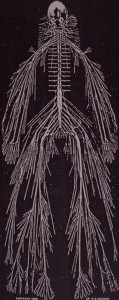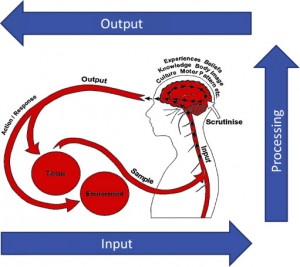On November 3rd & 4th I had the pleasure of taking the NeuroOrthopedic Institue course – Mobilisation of the Nervous System. I was lucky to have Adriaan Louw as the course instructor. I learned a tremendous amount over the weekend and returned to the clinic on Monday with an additional approach to treat patients with. The NOI provides a paradigm shift in the way we view the nervous system and pain. While it is impossible to cram a weekends worth of great information and techniques into a post, I’ll try to provide some key points I learned from the course.
NeuroOrthopedic Approach
Their approach is simple…Tissues Heal!!! If your patient is having pain and it doesn’t correlate with the normal tissue healing time then you should consider another mechanism. Traditional medicine usually assumes that pain is directly correlated with a pathoanatomical structure. It often ignores the influence of the PNS (neurodynamics) and CNS (central sensitization). The NeuroOrthopedic Approach allows you to treat the mechanism of pain (input, processing, output), regardless of whether or not you know the exact anatomical structure.
Nerve Principles
The Golden 3
It was highly emphasized throughout the course that nerves need 3 things to function properly. When they don’t get these 3 things is when most problems arise. And you can usually fix these problems by giving nerves back the 3 things they need.
- Blood
- Space
- Movement
Neuroplasticity
Neuroplasticity refers to the ability of the nervous system to adapt and alter it’s synapses in response to new information, sensory stimulation, development, dysfunction, or damage. This is widely known to most people when discussing the brain and the role of the CNS. However, the ability of the peripheral nervous system to adapt via the ion channels is often overlooked.
There are many different types of ion channels in the PNS. Our entry-level physiology education only emphasized the electrical ion channels. What we must consider is that there are many other types of ion channels that play a role in mechanical transport and conduction. Like the CNS, these ions change almost instantaneously and are highly adaptable. For example, when you hear on the news that a blizzard is coming, your ion channels immediately start to prepare by changing to handle the decrease in temperature.
The clinical pearl to consider with this is that your manual intervention and language can have direct influence on your patients nervous system (neuroplasticity, ion channels).
Neurodynamics & the Continuum

The Continuum of the Nervous System. Dissection by Rufus Weaver, MD. (Courtesy of Drexel University, Philadelphia, PA.)
Neurodynamics is “the study of the mechanics and physiology of the nervous system and how they relate to each other”. It encompasses how the nervous system interacts with the body on a physical, biological, and neurophysiological level. There are 5 Laws to Neurodynamics: Container Concept, Joint Relationship to Pressure & Load, Pinch & Elongate, Continuum, and Sequence & Order. While each law is equally important, the law of the Nervous System as a Continuum is a concept that many people overlook.
The nervous system is a closed-chain continuum, much like the tensegrity properties of fascia. Nerves do not move independently of each other. When you perform an SLR the whole nervous system moves, not just the sciatic nerve on the moving leg. Movement in one part of the nervous system will always result in movement in the rest of the system.
Clinically this becomes very useful when treating an acute or post-surgical patient. Mobilizing their adjacent nervous system will result in a low load mobilization of the affected area. This is something that can easily be implemented into your treatments tomorrow. The apprehensive neck patient, the post-op shoulder, the tender ankle sprain…these could all benefit from mobilizing the nervous system away from the site of injury. Dr. Louw discussed how effective this is with his acute whiplash patients. He places them in a brace and mobilizes the rest of the nervous system and has them perform light aerobic exercise on a treadmill. And they get better, faster.
Structural Differentiation
Structural Differentiation is to the nervous system what kinesiology is to ART or what the concave/convex rule is to joint mobs. It is using the continuum to examine, assess, and treat the nervous system. To fully understand this concept one must have knowledge of the peripheral nervous system the associated movements that tension and slacken the nerves. I have created a Neurodynamic Chart as a reference.
The concept of Structural Differentiation is simply manipulating the nervous system to either add or subtract tension to evoke a response. This will strengthen your neurogenic hypothesis during the examination and is the basis for treatment. For example, if you’re trying to differentiate a hamstring strain from a sciatic neurodynamic dysfucntion you would put the patient in the slump test position. If it is a neurodynamic dysfunction the patient will get relief from slackening the nervous system (either neck extension, lumbar extension, or ankle plantarflexion). If it is solely a hamstring strain the patient will have no relief with neck extension.
The 5 Base Tests (and further differentiation)
We were taught 8 “base tests” in the course. These base tests provide a starting point for assessing the peripheral nervous system. Using the Strucutral Differentiation concept you can adapt these tests to make them functional for your specific patient.
- Straight Leg Raise (Tibial, Common Peroneal, & Sural)
- Sidelying Slump Femoral (Obturator, Lateral Femoral Cutaneous)
- Slump (in sitting and in long sitting)
- Saphenous
- Upper Limb Tension Test (Median, Median 2, Radial, Ulnar)
Intervention
Treating the nervous system consists of applying the principles above to the individual. You want to bring blood, space, and movement to the system. Use the continuum and structural differentiation. Treat the containers (manual to surrounding tissues). Sliders and Tensioners. And explain pain (which is a whole ‘nother animal).
Of course this is an oversimplification, but the course wasn’t taught with a strict “in the box” intervention. Instead we were taught the principles, systems, and methods and encouraged to be creative when applying them to the specific patient. Since we are dealing with a highly adaptive individualized system, I think this process works best.
Bottom Line
There are many approaches for treating the musculoskeletal system, but very few approaches exist for the nervous system. The NOI group provides a great approach for this system and creates a great opportunity for clinicians to grow and add to their “tool box”. They’re not trying to get you to change the way you practice or trying to convince you to join a cult (like some of the other approaches out there). It’s not just a trendy method or technique. Instead, it’s a new way to view and treat your patients. It offers another “lens” to look through during assessments. It gives you more options for treatment. It allows you to confidently and systematically work with the the nervous system.
For further information on NOI Group and future courses click here.
—
The main reason I do this blog is to share knowledge and to help people become better clinicians/coaches. I want our profession to grow and for our patients to have better outcomes. Regardless of your specific title (PT, Chiro, Trainer, Coach, etc.), we all have the same goal of trying to empower people to fix their problems through movement. I hope the content of this website helps you in doing so.
If you enjoyed it and found it helpful, please share it with your peers. And if you are feeling generous, please make a donation to help me run this website. Any amount you can afford is greatly appreciated.





very useful guidelines and clear explanation about neurodynamics. My appreciation
Thank you for this clear and fullfilling information. I’m making my studies in understanding pain and giving lectures to different kind of people as a physiotherapist and acupuncturist , so this is helping me to make it more simple to exolain the complex of the pain .
Best regards , Maija Häärä from Finland